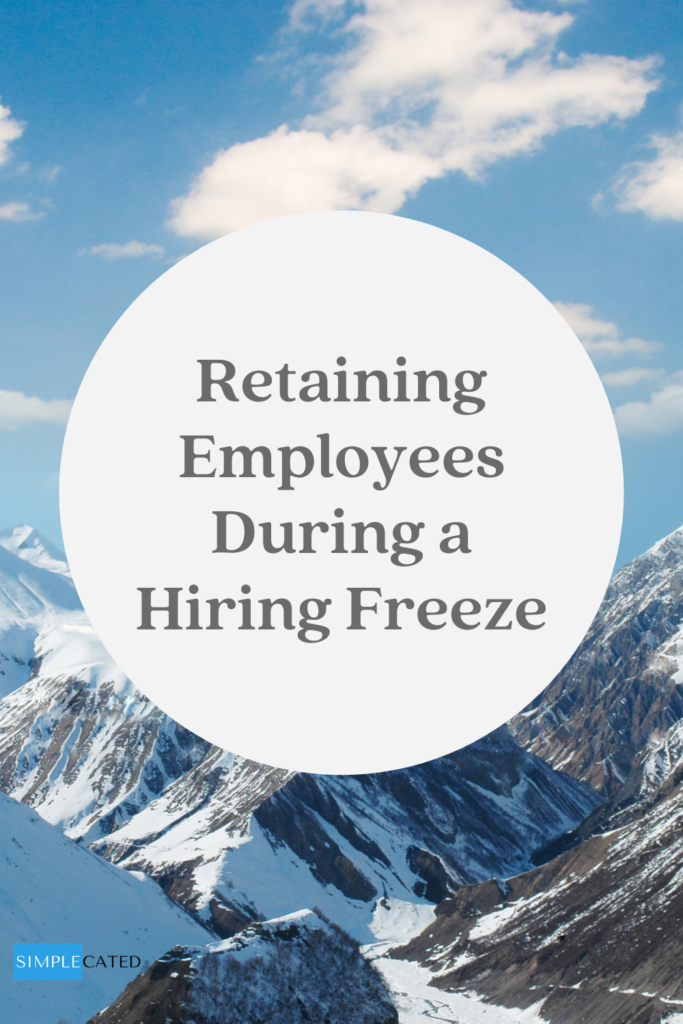Hiring freezes are common strategies when companies need to reduce costs. While the concept may easily make sense on the surface, it must be thoughtfully implemented to make sure you retain employees during a hiring freeze. Current employees dealing with an increased workload and no end in sight can lead to decreased morale, burnout, and turnover. In addition, both employees and applicants can become concerned about a company’s financial stability.
There are times when a hiring freeze is necessary. The company could have growing expenses and reduced revenue for a number of reasons, such as an unsuccessful new product or a pandemic like we’re experiencing right now. As a leader, you don’t want to put your company into financial instability by hiring employees you can’t support. You also don’t want to implement the kind of hiring freeze that makes things even worse by creating an unhealthy environment that causes you to lose valuable employees. A Forbes article explains that turnover can cost 33% of an employee’s salary. So, you want to do your best to retain your current employees.
Hiring freezes can be implemented in a number of ways depending on what the company needs. Given a hiring freeze will have a direct impact on your current employees as well as current and future applicants, careful planning is very important. How do you design and implement a hiring freeze in a way that takes care of your budget as well as your people?
Determine the cost-savings amount you need. Analyze your budget to determine the amount of expenses you need to cut. Once you know that dollar amount, consider various ways to reach it, thinking strategically about where you can handle reduced expenses while still keeping your company moving forward. In addition to a hiring freeze, you could consider reducing contract labor (which can be a significant expense), cutting extra programs or initiatives, and asking departments to reduce their budgets. Depending on the extent of your needs, you could also consider pay cuts and removing bonuses, in which case you would want to ensure your executive leaders set an example by receiving pay cuts themselves.
Review your vacancies, and determine how to apply the hiring freeze. Most likely, a blanket “no hiring” stance isn’t in your best interest. There may be certain vacancies that you need to fill in order for important work to keep happening and to maintain employee morale. Here are some strategies to consider as you review your vacancies:
- Allow hiring for essential jobs only. Which vacancies are “essential” depends a bit on your business needs at the time of the hiring freeze. Essential jobs could be the ones related to the core of your business. If you’re in the midst of a major project or initiative, it could be that those related vacancies are essential.
- Carve out leadership jobs. If you have leader vacancies, it may be important to fill them so you have leadership stability for your teams and the company.
- Allow for backfilling but not new positions. Filling vacancies due to employees leaving may need to remain a priority as your remaining employees could be struggling with higher workloads in the meantime. A hiring freeze could apply to new positions that add headcount.
- Differentiate full- and part-time openings. If some departments could survive with just a little bit more help, you could freeze full-time hiring but allow part-time hiring. Your salary cost would be lower, plus, you’d save the cost of full-time benefits.
- Consider temporary or contract assignments. As mentioned above, contract labor can be very expensive, so proceed with caution. Temporary or contract labor can be helpful if you only need temporary staffing or you need to have the flexibility to end an assignment quickly if the budget gets worse.
- Provide a review and exception request process. Some departments may have a unique need that should be taken into consideration, so provide a way for those leaders to make the case for an exception if they really need a specific vacancy to be filled. This helps your employees know that you value them and want to continue to support them during the hiring freeze.
Explain the “why.” Provide clear communication to your employees about why the hiring freeze is needed. Be transparent so they understand its necessity. Although you’re delivering news that may be difficult to hear, make sure to be positive and optimistic in your wording. Certainly, be truthful and honest – don’t make false promises or guarantees. Explain how implementing these steps will help the company continue to be successful. You simply want to reassure your employees that they don’t need to stress or be anxious about the future and that they can be confident in your leadership. Given timelines might change, set expectations but avoid guaranteeing a certain length of time for the hiring freeze. Outline what’s happening now and perhaps that it’s the plan for the next 30-60 days, and you’ll be reevaluating and will keep them updated.
Have a communication plan. Difficult messages like this are best delivered with a combination of written and face-to-face communication. Hiring freezes can create a lot of uncertainty, so it’s important for leaders to be prepared to effectively lead in the midst of the uncertainty. Consider delivering the news personally to executive leaders and then having the leaders continue delivering the news to each of their affected teams. Providing your leaders with a script and some FAQ information helps ensure clear, consistent messaging. If you have an HR department, they should be involved all along with way and can help navigate conversations with upset employees. If the hiring freeze will affect most or all of the company, consider sending written communication to everyone. This is not a good time to play the telephone game where each person passes the message around the circle to see what you end up with. You want to ensure that your message is the one received.
Keep applicants connected. For applicants who are affected, you’ll want to make sure they are told what’s happening and what they can expect. Provide recruiters with a script to use to ensure consistent messaging. Provide an appropriate amount of detail about the reason for the hiring freeze, and reassure them of your company’s future. Explain what’s happening with the job posting and their application so they know whether they’re remaining in the pipeline or need to reapply later. Have recruiters remain connected with these applicants so that you can fill vacancies quickly once the hiring freeze ends.
Review and adjust. Continually review the impact of the hiring freeze on your budget and your people so you can determine whether any changes need to be made to your strategy.
Hiring freezes are difficult decisions, but they can be necessary for a company’s financial stability and future success. Developing a thoughtful plan and providing clear communication from the beginning can go a long way in maintaining employee morale and helping you retain employees during a hiring freeze.
Photo credit: By esatokyay / Canva






Hi Rebecca! Nice timely post! I am currently in a position where I have had to furlough my student workers until further notice (I work in a university library). Since I am still working remotely, I am not picking up their usual duties of patron service, but I will have to when we return. I worry about getting my student team back whenever they may return. If I can’t get them back, I will have anywhere from three to four new people to train at one time. And, I will be sad if I lose my seasoned veteran of many years to this. I hoped to give her a grand farewell and thank you – it seems like a terrible way to end years of service. I like your idea of keeping in contact with them, and now I plan to send them an email weekly to let them know what is going on and if they have any questions. Thank you for your support! Best, Jacqueline
Hi Jacqueline! Thank you so much for your feedback, and thank you for sharing the difficult situation you’re experiencing. I think you have a great idea to email them weekly and provide them with updates. That will help them know what’s going on and what to expect next. Hopefully, they’re all ultimately able to return! If that unfortunately doesn’t happen, maybe everyone would still be able to join you for a nice farewell event for your seasoned veteran. These current circumstances have caused so many things to be different than how we imagined. I think you’re doing a great job trying to support your team!